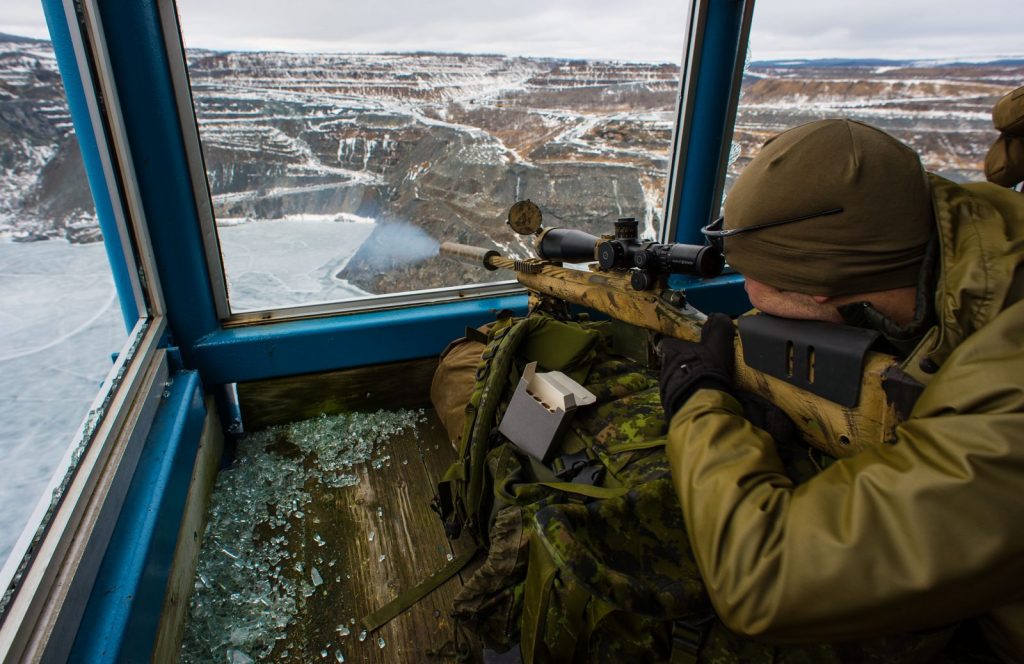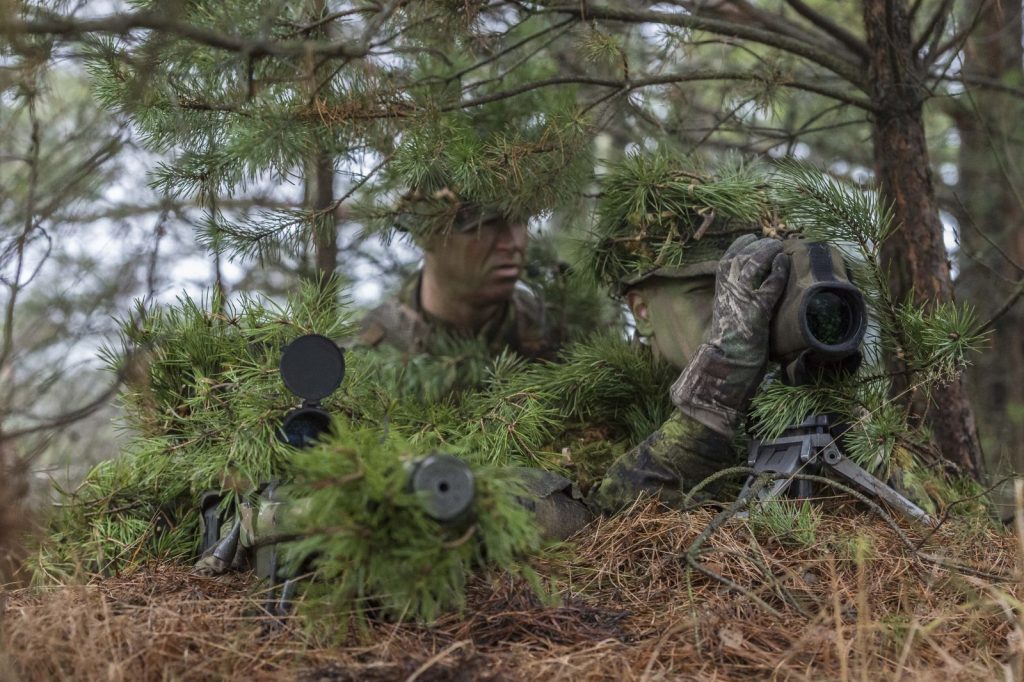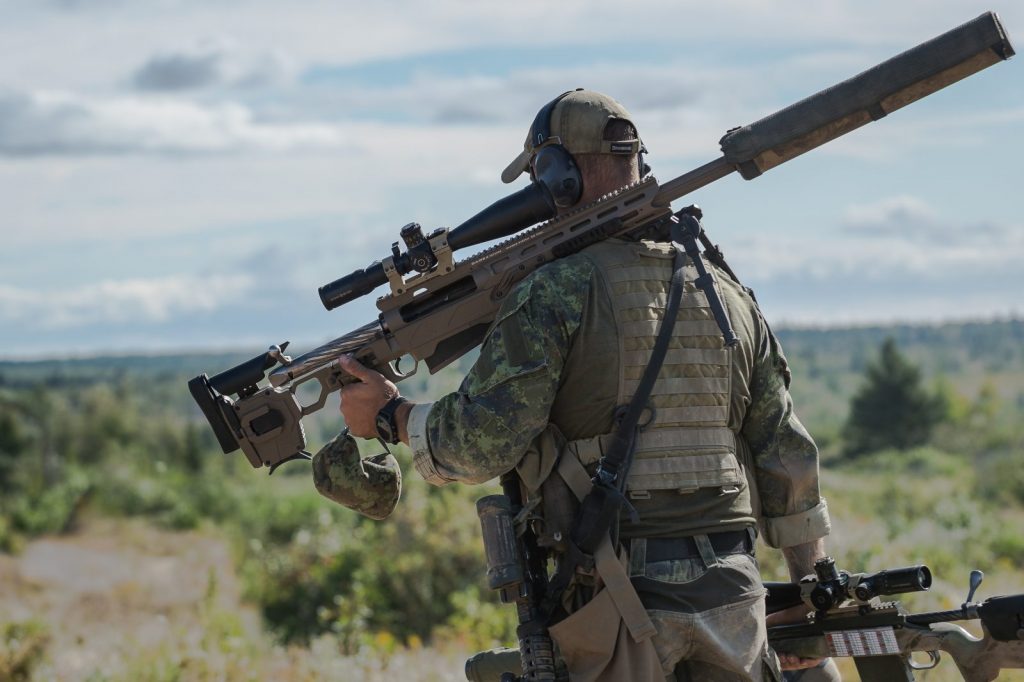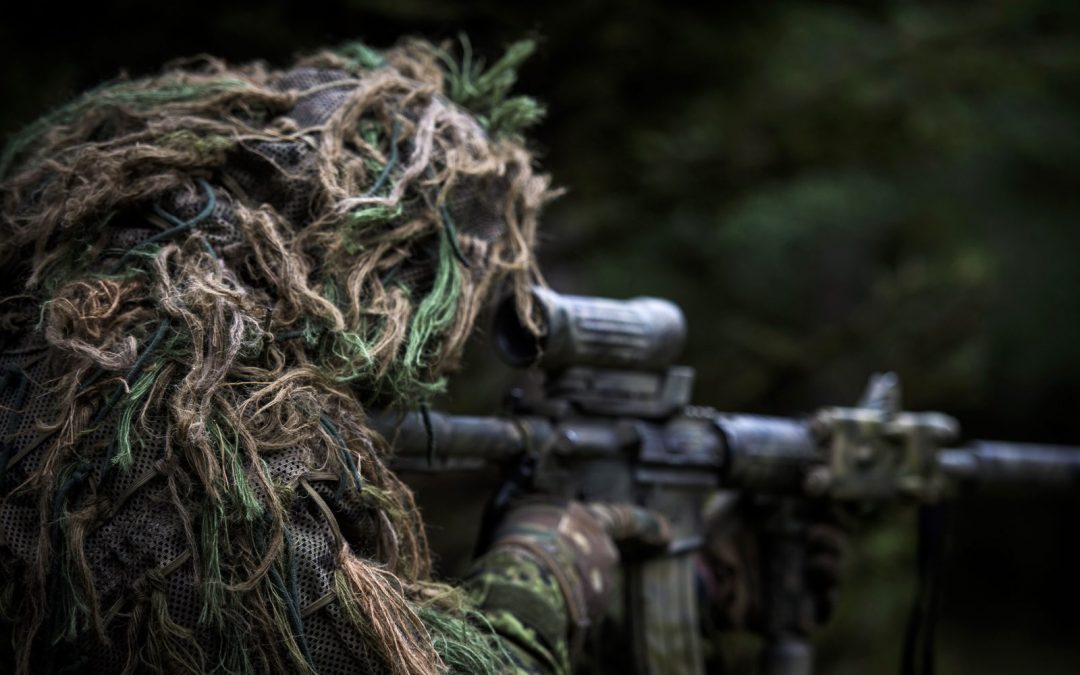by Ken Pole
Most of us can be trained to use firearms and, given practice, can learn to shoot well. That’s particularly true within the Canadian Armed Forces (CAF), where weaponry is a fundamental element of training at the CAF’s Leadership and Recruit School in Saint-Jean-sur-Richelieu, Que. However, as with any other activity, even military shooters have their elite: the snipers who provide overwatch to troops combat or take down “high-value targets” at long range.
There is widespread consensus that new guns and gear at the heart of a Sniper System Project (SSP), managed by the Canadian Army, is critical to the sniper mission. Canadian Army Today sat down for a freewheeling discussion with four individuals most involved in bringing SSP to fruition. Major Carl Gendron is a small arms project director in the Directorate of Land Requirements while Warrant Officer Mike Tousignant is a master sniper who did two tours in Afghanistan, as a shooter in 2004 and as a detachment (det) commander in 2008. The quartet was rounded out by Master Warrant Officer Stephen McDougall, life cycle materiel manager for sniper weapons, and John Yoshida, a retired Chief Warrant Officer and now life cycle materiel manager for small arms.
Gendron said sniping is physically one of the harshest trades, but there evidently is no shortage of personnel eager to test their limits. “Out of everyone in a unit, guys who are fit enough and can take it a step further, can do basic reconnaissance and advanced recce. From there, you’re going to take those who are toughest and more skilled and develop them as snipers. It’s not just because someone’s a good shot. Not at all. These are elite soldiers, through and through.”
Army sniper training is one of the most rigorous programs of its type anywhere, requiring tremendous dedication over many years. Aspiring snipers, who require approval by their commanding officer, are put through thorough physical and psychological assessments at their unit level before being sent for basic recce.
“It cuts down the numbers,” said Tousignant. “From a unit with 300-400 people on the ground, you end up with maybe 20 who can do the pre-course. Each time you run a course, say, in the RCRs (Royal Canadian Regiments 1, 2 and 3), each provides six candidates for one course.” Two other Regular Force elements, the Princess Patricia’s Canadian Light Infantry and the Royal 22nd Régiment or “Van Doos”, also have snipers.
“The guys in the sniper platoons are the ones who’ve gone above and beyond,” he elaborated. “You don’t have to do a basic recce course and put yourself through a little bit of torture for two months. These are people who want to move forward, want to be better at their jobs.”

5th Canadian Mechanized Brigade Group snipers conduct long range inclined shooting training in a closed mine during Exercise Tireur Incline in Thetford Mines, Que. Photo: Sgt Marc-André Gaudreault
Shooting is the end game, but missions often require getting a sniper team to and from a hide, whether at long range or relatively close in an urban theatre of operations. This can take hours, even days, compared with the seconds required to confirm a target and pull the trigger.
The overall project was granted preliminary approval in December 2010 at an “indicative” estimated cost of $35.76 million, including $11.31 million for commercially-available components (Phase 1) and an initial $11.31 million for elements requiring definition (Phase 2).
Phase 2 funding was eventually increased to $22.24 million in 2014, but “technical and contractual difficulties” with the sole-source procurements resulted in cancellation in 2015. A key issue was the planned refurbishment of existing rifles, but many parts were not interchangeable between weapons.
When planners updated the requirements and reviewed the procurement strategy, it was decided that all elements would be delivered as one phase. The overall cost estimate rose to $44.97 million because of the decision to go with new rifles and related technologies, with generally higher price tags.
Evolution in guns, ammunition and optics, coupled with the advent of advanced ballistics calculators (ABCs), have made today’s snipers more effective at long ranges, but the human factor still prevails.
“Snipers provide a core land capability through the delivery of highly precise, direct fire on selected targets beyond the range and accuracy of general-purpose small arms,” according to an Army project brief. “This capability provides economy of force, minimization of collateral damage, and a compelling psychological effect on the enemy.”
They also are used for purposes other than protecting CAF assets, such as supporting counter-insurgency missions, assisting civilian police forces at events such as international Summits and protecting non-government organizations operating in a hostile region.
“Sniper survivability relies upon the ability to remain undetected throughout the mission,” the brief points out. “The high level of training must be complemented by careful selection of specialist weapons, clothing and equipment.”
The Army has acquired a range of sniper equipment in small numbers over the past couple of decades as deficiencies were identified. They included the lack of a battle management system, generally heavy gear, and inadequate communications, night-vision gear and camouflage systems.
During the same period, engagement ranges increased from a few hundred metres to kilometres – the current world record of 3.54km is held by a Canadian sniper.
“The effects of weather over these longer distances introduced a dramatic increase to the complexity of calculating bullet trajectory,” the brief explains. “Although individual components of sniper equipment function as intended, the lack of integration significantly increases … complexity in a role that is already mentally and physically demanding.”

A Canadian Armed Forces sniper participating in Exercise Without Warning in the training area of Glebokie, Poland during Operation Reassurance.
Photo: Cpl Nathan Moulton
The Army maintains a vault where an array of firearms is secured, having been acquired from manufacturers worldwide for in-house experts to assess and potentially make recommendations on how they might best meet mission requirements.
The inventory includes sniper rifles from Cadex Defence in Saint-Jean-sur-Richelieu, as well as Sako in Finland, which developed the new Canadian Ranger rifle, Accuracy International, founded by a former Olympic shooting medallist and headquartered in England, and Barrett Firearms Manufacturing, a Tennessee-based company whose .50-calibre rifles have become almost synonymous with sniper warfare.
“It’s difficult for the requirements people to really understand what they can have if they don’t see what’s available,” Yoshida explained. “We purchase these things, take them out on the range so the Army fellows can understand what features are desirable and which are not so useful.”
That way, requirements can be written based on “the realm of the possible,” as opposed to what might not be field-ready. For example, planners may decide snipers could benefit from a laser rangefinder. “But if that’s not available on the market today, they’ve wasted that procurement and gone through this whole exercise without an understanding of what’s really available,” he said.
The collection in the vault includes several multi-calibre weapons which fire both 7.62mm and .338-cal rounds. This enables the same chassis to be used for training with the smaller NATO ammunition, which not only costs approximately a third of the .338, but also reduces wear and tear on the gun. “We don’t have much experience with this type of weapon,” Yoshida added, “so we have the ability to purchase and evaluate them.”
Multi-calibre is one of the requirements for the new sniper rifle that will replace the current C14, chambered for .338 rounds, and the 1970s-vintage C3 rifles, chambered for 7.62mm. “The .338 is a magnum round,” Gendron said. “By putting the 7.62mm barrel on the same frame as the .338, we can retain the scope and keep the same form, fit and function.” Final technical specifications for the new multi-calibre rifle have been completed and it should go to tender shortly. The winning bid will become the C21 MCSW (Multi-Caliber Sniper Weapon), which will be the cornerstone of the sniper system for years to come.
The goal is a semi-automatic with the same accuracy as a bolt-action rifle. This has led to collaboration with Colt Canada on the design of the C20 SASW (Semi-Automatic Sniper Weapon) that fires a new .338 match round. Tousignant said snipers with minimal time on the C20 had been hitting accurately at 800 metres – maybe not always with the first round but routinely with following shots. Gendron said the new round has enough energy to reach out to a kilometre. The C20 has passed all the acceptance tests and will go into production at Colt Canada once the contract is let by PSPC.
A semi-automatic enables snipers to engage targets in rapid succession. “Not every situation is going to require the sniper and his No. 2 giving him all the information and the ballistics corrections required to make a very long shot,” Gendron said. “Sometimes, within 1,000 metres, you want to have snipers attached to the infantry as overwatch and they will not have time to check their computers for an exact ballistic solution. It might be a target-rich environment and that’s where we can fire semi-auto with the accuracy of a typical sniper rifle.”

Soldiers and police forces from 12 countries participated in the annual Canadian International Sniper Concentration in the training area of the Canadian Forces Base Gagetown in September 2018. Photo: Cpl Nicolas Alonso
At one point in the sniper world, there was not much beyond the standard 7.62mm. “If you wanted a bigger punch at longer range, you had to go the .50-cal,” he explained. The problem is the daunting physical challenge of crawling or stalking with the heavy .50-cal. Physiology also comes into play as shooting such large-calibre rifles can lead to injuries, even for experienced snipers. A .50-cal shot has so much kinetic energy that it can push the gun bipod and shooter back as much as a foot, making a follow-on shot difficult.
Gendron said there is general agreement that the cartridge is too powerful. “A big cartridge needs a big frame to handle the power so there had to be something in between the 7.62mm and the .50. That’s when the .338 requirement came out, to defeat a target at 1,500 metres. It took 10 years to figure out exactly the right bullet. The .338 has a similar trajectory to the .50 in a much smaller frame.” So the .50 cal has become more of an overwatch and anti-materiel weapon, upgraded ergonomically.
Beyond just the shooting aspect, sniper missions can last several days, which is why the project involves a catalogue of supporting gear. While on a course last year, Tousignant looked closely at load carriage and tactical mobility, including increased reliance on small all-terrain vehicles (ATVs) to reduce, where practicable, the time it takes to get closer to targets. During the course, he gave detachment commanders from all across Canada a very general mission scenario and asked them to write up a detailed description on what each member of the detachment would carry.
“Then I had each kit weighed,” he grinned. “Human factors would indicate that you give the bigger guys more equipment.” Apparently not in the real world. “The kit you carry depends on your role in the det. So, yeah, maybe if you’re carrying the .50-cal and you’re the smallest guy, you might end up with the heaviest load.”
Tousignant said new designs of rucksacks, body armour, armour plate carriers and fragment vests afford soldiers much more flexibility while letting more body heat escape and reducing hydration needs.
Modular designs enable troops to leave unnecessary elements at base while they carry only mission-critical gear closer to their target.
Since light infantry battalions have ATVs, “there’s no need [for sniper teams] to carry extreme weights for kilometres, which was the way we operated before,” said McDougall.
Then there are the ballistics calculators, first used by Canadian snipers in 2004 on the .50-cal gun the Army had acquired only a couple of years earlier. “We were kind of going from scratch,” Tousignant recalled. “In trying to gather information at various ranges, you basically had to shoot them. Two hundred metres, 300, 400, 500 out to 2,000 is a lot of rounds through the .50 and it’s pretty hard on your body. Also, we didn’t have suppressors, only the muzzle brakes, so there was a little bit of extra concussion.” Attached to a muzzle, the brake redirects gases, helping to counter recoil and muzzle rise.
The original calculators were hardware with integral software; upgrades required shipment back to the manufacturer. “We managed over the years to go through three systems like that and finally got to the point where we decided to build a program that could be installed into any Android phone or tablet,” he said.
When the advanced ballistic compensation is Bluetooth-linked to the sniper’s handheld Garmin Kestrel weather station and a laser range finder, “you basically have a sensor suite giving you anything you need to make a correction on the ballistics. It speeds up what would otherwise be a lengthy procedure when done by hand,” Tousignant added.
In other words, “there’s an App for that!” Gendron noted that it’s much cheaper to replace a phone that can cost a few hundred dollars than a ruggedized system worth $10,000. But the question remains: Is there too much reliance on technology in a discipline where the fundamentals haven’t changed for decades?
“The biggest thing is wind,” Tousignant replied. “We don’t yet have that in the ballistic calculator, what the winds are doing down range at, say, 1,000 metres.” But once shooters have used the calculator long enough, they’ll trust the software. “The guys are using it and it’s very comparable to the top ballistic programs out there right now.”
Improved ballistics calculations are but one part of the overall project, much like the sniper teams are but one element of the Canadian Army. In its 2017 policy, Strong, Secure, Engaged, the government committed to giving the CAF “the modern tools they need to succeed in … operations.” Just below those words is a prominent image of a sniper team. Coincidence? Probably, but there’s no gainsaying the prominent role sniper teams play in keeping their comrades-in-arms safe while enhancing overall operations.


Quote – “The goal is a semi-automatic with the same accuracy as a bolt-action rifle. This has led to collaboration with Colt Canada on the design of the C20 SASW (Semi-Automatic Sniper Weapon) that fires a new .338 match round.”
Check your facts, the SASW fires a 7.62 match not a .338.